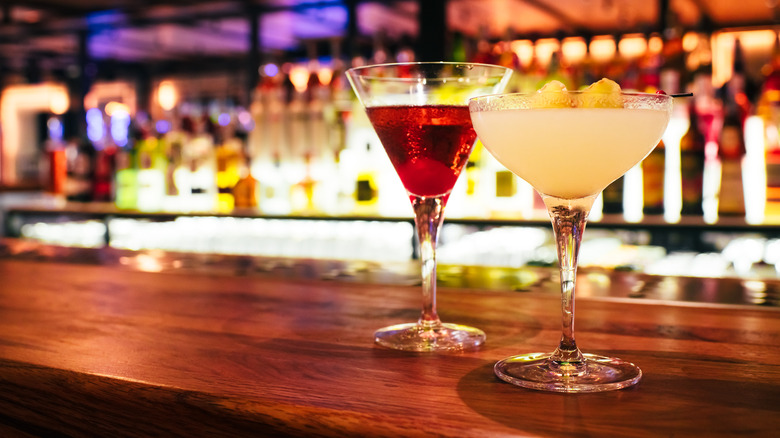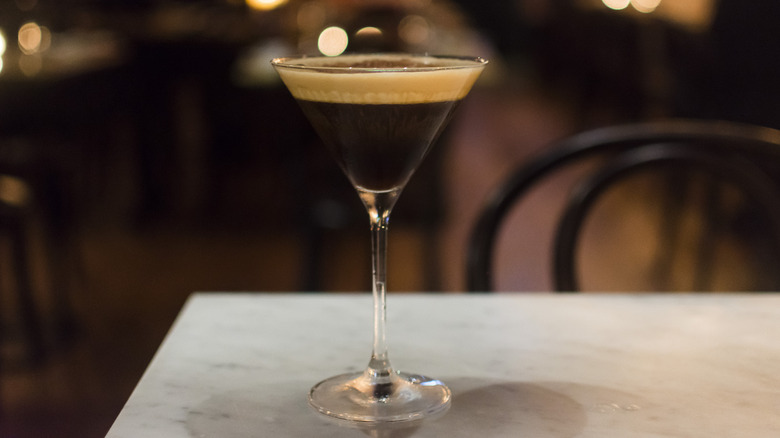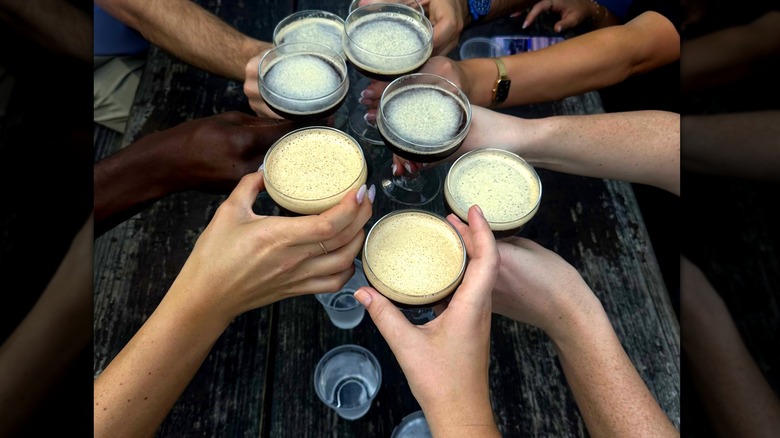The '80s Coffee Cocktail That's Making A Most Triumphant Comeback
We may receive a commission on purchases made from links.
When mixed drink trends take off, it's easy to think they are either new concepts or very old, traditional drinks. When it comes to the espresso martini, the answer lies somewhere in between. Over the past few years, the cocktail has experienced a massive resurgence, and is considered one of the most popular drink orders these days, up there with the margarita and old fashioned. For those just discovering this invigorating blend of vodka, espresso, and coffee liqueur, it may feel like the espresso martini is a trendy new concoction. In fact, it's been around for almost 40 years, and saw broad popularity for the first time in the late 1980s into the '90s. That era saw the appearance of a number of new party cocktails besides the espresso martini, including the appletini, cosmopolitan, and sea breeze.
While those three drinks are generally believed to have originated in the United States, it's probably the late London bartender and personality Dick Bradsell who morphed alcohol-spiked coffee into coffee-spiked alcohol before eventually tossing it in a martini glass. These days, espresso martinis and unusual riffs such as the Guinness espresso martini seem to be everywhere. In fact evidence suggests that sales in bars, and the ready-to-drink versions in liquor stores, have been on the rise since 2020.
The origins of the espresso martini
The story goes that Bradsell was working in a London hot spot in the '80s. There, a future supermodel from America asked him for something that would provide her both energy and a boozy buzz (her phrasing was more rugged). He grabbed coffee and vodka, combined the two over ice, and made the vodka espresso. By the late 1980s, the drink lost the ice, gained coffee liqueur, and the iconic V-shaped glass. The name evolved to the pharmaceutical stimulant, then the espresso martini.
Details of the story changed over time, including when and where Bradsell developed the drink. He said in a 2011 interview (via Punch) that he just assumed the woman who placed the order was a model. But most people in the industry accept his story since Bradsell was well-respected and a prolific drinks creator. Following his death in 2016, London-based cocktail historians Jared Brown and Anistatia Miller were tasked by Bradsell's daughter to compile and edit his copious notes into a book called "Dicktales or 'Thankyous and Sluggings'."
"There were pages and pages on the espresso martini," Brown told Chowhound. "Re: its origin, he not only wrote it out exhaustively, he signed it with, 'Doubt and confusion? Not me, I was there'." Regardless, the drink became a hit in America and around the world throughout much of the 1990s. By the mid-2000s, its popularity faded, as spirit-forward craft cocktails such as the negroni took the reins. Except in Australia.
The 2020s gives the espresso martini new life
The espresso martini was more or less forgotten in the United States (or regarded as a joke) as recently as 2015. It apparently took a pandemic and a '90s retro craze for the cocktail to come back in vogue. In 2022, Forbes reported that the espresso martini had surpassed the Manhattan in popularity. In fact, the concurrent rise in 90s retro fashions and trends may be playing a hand in the drink's popularity, particularly for younger drinkers. By 2022, the drink had experienced a full reversal in the U.S. with some publications declaring it the drink of the year. By the end of 2023, bar industry website Union ranked it as the number-three ordered cocktail, and it shows no signs of slowing down.
The drink is so popular it's spawned a concept called the espresso martini effect, where one person ordering it encourages everyone around them to place an order. It's credited with leading to the idea that some bartenders hate making espresso martinis, though many bartenders dispute that assertion. Making them at home? Swap out cold brew for hot espresso to make an extra smooth martini.


